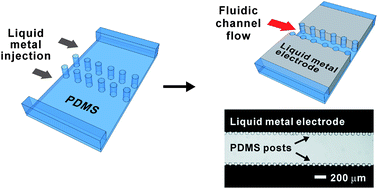This paper describes the fabrication and characterization of microelectrodes that are inherently aligned with microfluidic channels and in direct contact with the fluid in the channels. Injecting low melting point alloys, such as eutectic gallium indium (EGaIn), into microchannels at room temperature (or just above room temperature) offers a simple way to fabricate microelectrodes. The channels that define the shape and position of the microelectrodes are fabricated simultaneously with other microfluidic channels (i.e., those used to manipulate fluids) in a single step; consequently, all of the components are inherently aligned. In contrast, conventional techniques require multiple fabrication steps and registration (i.e., alignment of the electrodes with the microfluidic channels), which are technically challenging. The distinguishing characteristic of this work is that the electrodes are in direct contact with the fluid in the microfluidic channel, which is useful for a number of applications such as electrophoresis. Periodic posts between the microelectrodes and the microfluidic channel prevent the liquid metal from entering the microfluidic channel during injection. A thin oxide skin that forms rapidly and spontaneously on the surface of the metal stabilizes mechanically the otherwise low viscosity, high surface tension fluid within the channel. Moreover, the injected electrodes vertically span the sidewalls of the channel, which allows for the application of uniform electric field lines throughout the height of the channel and perpendicular to the direction of flow. The electrodes are mechanically stable over operating conditions commonly used in microfluidic applications; the mechanical stability depends on the magnitude of the applied bias, the nature of the bias (DC vs. AC), and the conductivity of the solutions in the microfluidic channel. Electrodes formed using alloys with melting points above room temperature ensure mechanical stability over all of the conditions explored. As a demonstration of their utility, the fluidic electrodes are used for electrohydrodynamic mixing, which requires extremely high electric fields (∼105 V m−1).

You have access to this article
 Please wait while we load your content...
Something went wrong. Try again?
Please wait while we load your content...
Something went wrong. Try again?


 Please wait while we load your content...
Please wait while we load your content...